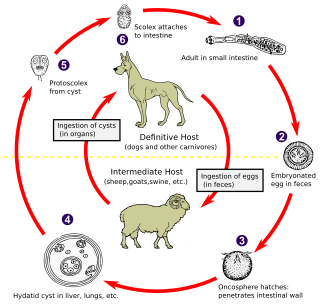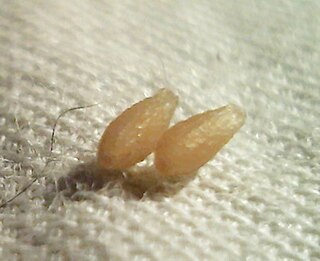
Echinococcosis is a parasitic disease of tapeworms of the Echinococcus type. The two main types of the disease are cystic echinococcosis and alveolar echinococcosis. Less common forms include polycystic echinococcosis and unicystic echinococcosis.
Veterinary parasitology is a branch of veterinary medicine that deals with the study of morphology, life-cycle, pathogenesis, diagnosis, treatment, and control of eukaryotic invertebrates of the kingdom Animalia and the taxon Protozoa that depend upon other invertebrates and higher vertebrates for their propagation, nutrition, and metabolism without necessarily causing the death of their hosts. Modern parasitology focuses on responses of animal hosts to parasitic invasion. Parasites of domestic animals,, as well as wildlife animals are considered. Data obtained from parasitological research in animals helps in veterinary practice and improves animal breeding. The major goal of veterinary parasitology is to protect animals and improve their health, but because a number of animal parasites are transmitted to humans, veterinary parasitology is also important for public health.

Praziquantel (PZQ), sold under the brandname Biltricide among others, is a medication used to treat a number of types of parasitic worm infections in mammals, birds, amphibians, reptiles, and fish. In humans specifically, it is used to treat schistosomiasis, clonorchiasis, opisthorchiasis, tapeworm infections, cysticercosis, echinococcosis, paragonimiasis, fasciolopsiasis, and fasciolosis. It should not be used for worm infections of the eye. It is taken by mouth.

Tapeworms of the order Cyclophyllidea are the most important cestode parasites of humans and domesticated animals. All have multiple proglottid "segments", and all have four suckers on their scolices (heads), though some may have other structures, as well. Proglottids of this order have genital openings on one side, and a compact yolk gland or vitellarium posterior to the ovary.

Echinococcus is a genus within Cestoda, a parasitic class of the platyhelminthes phylum. Human echinococcosis is an infectious disease caused by the following species: E. granulosus, E. multilocularis, or E. vogeli.

Echinococcus granulosus, also called the hydatid worm, hyper tape-worm or dog tapeworm, is a cyclophyllid cestode that dwells in the small intestine of canids as an adult, but which has important intermediate hosts such as livestock and humans, where it causes cystic echinococcosis, also known as hydatid disease. The adult tapeworm ranges in length from 3 mm to 6 mm and has three proglottids ("segments") when intact—an immature proglottid, mature proglottid and a gravid proglottid. The average number of eggs per gravid proglottid is 823. Like all cyclophyllideans, E. granulosus has four suckers on its scolex ("head"), and E. granulosus also has a rostellum with hooks. Several strains of E. granulosus have been identified, and all but two are noted to be infective in humans.

Echinococcus multilocularis is a small cyclophyllid tapeworm found extensively in the northern hemisphere. E. multilocularis, along with other members of the Echinococcus genus, produce diseases known as echinococcosis. Unlike E. granulosus,E. multilocularis produces many small cysts that spread throughout the internal organs of the infected animal. The resultant disease is called Alveolar echinococcosis, and is caused by ingesting the eggs of E. multilocularis.

Dipylidium caninum, also called the flea tapeworm, double-pored tapeworm, or cucumber tapeworm is a cyclophyllid cestode that infects organisms afflicted with fleas and canine chewing lice, including dogs, cats, and sometimes human pet-owners, especially children.

The Taeniidae are a family of tapeworms. It is the largest family representing the order Cyclophyllidea. It includes many species of medical and veterinary importance, as Taenia solium, Taenia saginata, and Echinococcus granulosus. The Taeniidae are parasites of mammals and many are infectious to humans.

Fenbendazole is a broad spectrum benzimidazole anthelmintic used against gastrointestinal parasites including: giardia, roundworms, hookworms, whipworms, the tapeworm genus Taenia, pinworms, aelurostrongylus, paragonimiasis, strongyles, and strongyloides that can be administered to sheep, cattle, horses, fish, dogs, cats, rabbits, most reptiles, freshwater shrimp tanks as planaria and hydra treatments, as well as seals.
Professor Marshall Lightowlers began his career in the field of parasitology during a post-doctoral appointment at the Institute of Medical and Veterinary Science in Adelaide where he undertook research on ovine sarcocystosis. In 1981 he began a post-doctoral position at The University of Melbourne, Veterinary Clinical Centre and commenced a research career focusing on the immunology and molecular biology of taeniid cestode parasites. His initial research at the University of Melbourne investigated the immunochemistry of antigens of Taenia taeniaeformis and Echinococcus granulosus. Subsequently he was a member of a team of scientists that developed a vaccine against Taenia ovis infection in sheep, the first recombinant vaccine against a parasitic disease. In 1989 Lightowlers took over leadership of the molecular parasitology research laboratories at the University of Melbourne and began applying the lessons learnt with T. ovis to the development of similar vaccines against infection with the larval stages of other cestode parasites. This led to the development of highly effective, recombinant vaccines against cysticercosis in cattle due to Taenia saginata (TSA9/TSA18) and in pigs due to Taenia solium. In collaboration with Dr David Heath at the Wallaceville Animal Research Centre in New Zealand, he and his colleagues also developed the EG95 recombinant vaccine against cystic echinococcosis.

Cestoda is a class of parasitic worms in the flatworm phylum (Platyhelminthes). Most of the species—and the best-known—are those in the subclass Eucestoda; they are ribbon-like worms as adults, known as tapeworms. Their bodies consist of many similar units known as proglottids—essentially packages of eggs which are regularly shed into the environment to infect other organisms. Species of the other subclass, Cestodaria, are mainly fish infecting parasites.

Taenia taeniaeformis is a parasitic tapeworm, with cats as the primary definitive hosts. Sometime dogs can also be the definitive host. The intermediate hosts are rodents and less frequently lagomorphs (rabbits). The definitive host must ingest the liver of the intermediate host in order to acquire infection. The worm tends to be white, thick bodied, and around 15 to 60 cm in length. This species of tape worm is much less frequently encountered than Dipylidium caninum, which has fleas as its intermediate host rather than rodents but exhibits most of the same physical characteristics and is treated with the same medications.

Nitroscanate is an anthelmintic drug used in veterinary medicine to treat Toxocara canis, Toxascaris leonina, Ancylostoma caninum, Uncinaria stenocephala, Taenia, and Dipylidium caninum.
Taenia serialis, also known as a canid tapeworm, is found within canines such as foxes and dogs. Adult T. serialis are parasites of carnivores, particularly dogs, with herbivorous lagomorph mammals such as rabbits and hares, serving as intermediate hosts. In definitive hosts, T. serialis is acquired by eating tissues from a variety of intermediate hosts. Accidental infection of humans though, can occur when eggs are ingested from food or water contaminated with dog feces and the human then becomes the T. serialis intermediate host.
The term cat tapeworm may refer to:
The term feline tapeworm may refer to:

Rostellum in helminthology is a protruding part of the anterior end of tapeworms. It is a retractable, cone-like muscular structure that is located on the apical end of the scolex, and in most species is armed with hooks, the organs of attachment to the host's intestinal wall. It is a parasitic adaptation in some cestodes for firm attachment in the gastrointestinal tract and is structurally different from one species to another, thereby becoming an important diagnostic feature.













